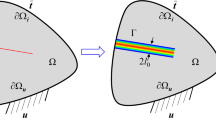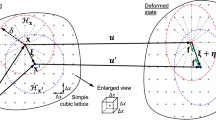Abstract
How to numerically describe and reveal the mixed tensile-shear fracture in metallic structures subjected to impulsive loadings is still a challenging problem due to the complexity that both fracture initiation and crack formation are strongly affected by the stress states induced by the dynamic impulse loadings. In this paper, an elastic–plastic phase-field model is developed to capture the mixed tensile-shear ductile fracture of impulsively loaded metal plates. Compared with the existing elastic–plastic phase-field fracture model, the stress triaxiality and Lode parameter dependent fracture initiation energy threshold locus and equivalent effective critical energy release rate are introduced to describe the stress state-dependent fracture initiation and crack formation under complex loadings. The damage parameters used in the proposed model can be calibrated with standard test data, and the calibrated model is applied to study the dynamic failure of clamped mild steel plates subjected to impulsive loading. The results show that the predicted dynamic failure of metal plates under different impulse loadings compares well with the experimental results, which verifies the ability of the proposed model to simulate ductile fracture under complex stress states. The competitive mechanism of tensile and shear fracture during the process from partial to complete tearing of the plate is further revealed. It can be concluded that as the damage evolves, the stress state in the material would approach the one with a lower equivalent effective critical energy release rate, which maximizes the energy dissipation through the fracture. This study is meaningful for evaluating and designing metal structures with better dynamic load-carrying capacity.






















Similar content being viewed by others
References
Aldakheel F, Wriggers P, Miehe C (2018) A modified Gurson-type plasticity model at finite strains: formulation, numerical analysis and phase-field coupling. Comput Mech 62:815–833
Ambati M, Gerasimov T, Lorenzis LD (2015) Phase-field modeling of ductile fracture. Comput Mech 55:1017–1040
Ambati M, Kruse R, Lorenzis LD (2016) A phase-field model for ductile fracture at finite strains and its experimental verification. Comput Mech 57:149–167
Anvari M, Liu J, Thaulow C (2007) Dynamic ductile fracture in aluminum round bars: experiments and simulations. Int J Fract 143:317–332
Areias P, Msekh MA, Rabczuk T (2016a) Damge and fracture algorithm using the screened Poisson equation and local remeshming. Eng Fract Mech 158:116–143.
Areias P, Rabczuk T, Msekh MA (2016b) Phase-field analysis of finite-strain plates and shells including element subdivision. Comput Methods Appl Mech Eng 312:322–350.
Bai Y, Wierzbicki T (2008) A new model of metal plasticity and fracture with pressure and Lode dependence. Int J Plast 24:1071–1096
Bai Y, Wierzbicki T (2010) Application of extended Mohr-Coulomb criterion to ductile fracture. Int J Fract 161:1–20
Bao Y, Wierzbicki T (2004) On fracture locus in the equivalent strain and stress triaxiality space. Int J Mech Sci 46:81–98
Bensaada R, Kanit T, Imad A, Almansba M, Saouab A (2022) Void-growth computational analysis in elastic-plastic porous materials. Int J Mech Sci 217:107021
Benzerga A, Leblond JB, Needleman A, Tvergaard V (2016) Ductile failure modeling. Int J Fract 201:29–80
Bergo S, Morin D, Hopperstad OS (2021) Numerical implementation of a non-local GTN model for explicit FE simulation of ductile damage and fracture. Int J Solids Struct 219–220:134–150
Borden MJ, Verhoosel CV, Scott MA, Hughes TJR, Landis CM (2012) A phase-field description of dynamic brittle fracture. Comput Methods Appl Mech Eng 217–220:77–95
Borden MJ, Hughes TJR, Landis CM, Anvari A, Lee IJ (2016) A phase-field formulation for fracture in ductile materials: finite deformation balance law derivation, plastic degradation, and stress triaxiality effects. Comput Methods Appl Mech Eng 312:130–166
Bourdin B (2007) Numerical implementation of the variational formulation for quasi-static brittle fracture. Interface Free Bound 9:411–430
Bourdin B, Francfort GA, Marigo J-J (2000) Numerical experiments in revisited brittle fracture. J Mech Phys Solids 48:797–826
Brünig M, Gerke S, Schmidt M (2018) Damage and failure at negative stress triaxialities: experiments, modeling and numerical simulations. Int J Plast 102:70–82
Bryant EC, Sun W (2018) A mixed-mode phase field fracture model in anisotropic rocks with consistent kinematics. Comput Methods Appl Mech Eng 342:561–584
Chaboche JL (1988) Continuum damage mechanics: part II-damage growth, crack initiation, and crack growth. J Appl Mech 55:65–72
Chu D, Li X, Liu Z (2017) Study the dynamic crack path in brittle material under thermal shock loading by phase field modeling. Int J Fract 208:115–130
Chu D, Li X, Liu Z, Cheng J, Wang T, Li Z, Zhuang Z (2019) A unified phase field damage model for modeling the brittle-ductile dynamic failure mode transition in metals. Eng Fract Mech 212:197–209
Driemeier L, Moura RT, Machado IF, Alves M (2015) A bifailure specimen for accessing failure criteria performance. Int J Plast 71:62–86
Farren WS, Taylor GI (1925) The heat developed during plastic extension of metals. Proc Roy Soc Lond A 107:422–451
Fei F, Choo J (2021) Double-phase-field formulation for mixed-mode fracture in rocks. Comput Methods Appl Mech Eng 376:113655
Feng Y, Li J (2022) Phase-field method with additional dissipation force for mixed-mode cohesive fracture. J Mech Phys Solids 159:104693
Francfort GA, Marigo J-J (1998) Revisiting brittle fracture as an energy minimization problem. J Mech Phys Solids 46:1319–1342
Freund LB (1998) Dynamic fracture mechanics. Cambridge University Press, Cambridge
Goswami S, Anitescu G, Chakraborty S, Rabczuk T (2020) Transfer learning enhanced physics informed neural network for phase-field modeling of fracture. Theor Appl Fract Mec 106:102447
Gurson AL (1977) Continuum theory of ductile rupture by void nucleation and growth: part I-yield criteria and flow rules for porous ductile media. J Eng Mater Technol 99:2–15
Irwin G (1948) Fracture dynamics, fracturing of metals. American Society of Metals, Cleveland
Johnson GR, Cook WH (1985) Fracture characteristics of three metals subjected to various strains, strain rates, temperatures and pressures. Eng Fract Mech 21:31–48
Jouri WS, Jones N (1988) The impact behaviour of aluminium alloy and mild steel double-shear specimens. Int J Mech Sci 30:153–172
Lemaitre J (1985) A continuous damage mechanics model for ductile fracture. J Eng Mater Technol 107:83–89
Li Y, Wierzbicki T (2010) Prediction of plane strain fracture of AHSS sheets with post-initiation softening. Int J Solids Struct 47:2316–2327
Lou Y, Chen L, Clausmeyer T, Tekkaya AE, Yoon JW (2017) Modeling of ductile fracture from shear to balanced biaxial tension for sheet metals. Int J Solids Struct 112:169–184
McAuliffe C, Waisman H (2015) A unified model for metal failure capturing shear banding and fracture. Int J Plast 65:131–151
McAuliffe C, Waisman H (2016) A coupled phase field shear band model for ductile-brittle transition in notched plate impacts. Comput Methods Appl Mech Eng 294:486–522
Miehe C, Hofacker M, Welschinger F (2010a) A phase field model for rate-independent crack propagation: robust algorithmic implementation based on operator splits. Comput Methods Appl Mech Eng 199:2765–2778
Miehe C, Welschinger F, Hofacker M (2010b) Thermodynamically consistent phase-field models of fracture: variational principles and multi-field FE implementations. Int J Numer Meth Eng 83:1273–1311
Miehe C, Hofacker M, Schänzel LM, Aldakheel F (2015) Phase field modeling of fracture in multi-physics problems. Part II. Coupled brittle-to-ductile failure criteria and crack propagation in thermos-elastic-plastic solids. Comput Methods Appl Mech Eng 294:486–522
Miehe C, Aldakheel F, Raina A (2016) Phase field modeling of ductile fracture at finite strains: a variational gradient-extended plasticity-damage theory. Int J Plast 84:1–32
Moriello DS, Bosi F, Torii R, Tan PJ (2020) Failure and detachment path of impulsively loaded plates. Thin-Walled Struct 155:106871
Needleman A, Tvergaard V (1984) An analysis of ductile rupture in notched bars. J Mech Phys Solids 32:461–490
Nguyen VP, Wu J-Y (2018) Modeling dynamic fracture of solids with a phase-field regularized cohesive zone model. Comput Methods Appl Mech Eng 340:1000–1022
Nurick GN, Shave GC (1996) The deformation and tearing of thin square plates subjected to impulsive loads-an experimental study. Int J Impact Eng 18:99–116
Olson MD, Nurick GN, Fagnan JR (1993) Deformation and rupture of blast loaded square plates-predictions and experiments. Int J Impact Eng 12:279–291
Pineau A, Benzerga A, Pardoen T (2016) Failure of metals I: brittle and ductile fracture. Acta Mater 107:424–483
Rabczuk T, Belytschko T (2004) Cracking particles: a simplified meshfree method for arbitrary evolving cracks. Int J Numer Methods Eng 61:2316–2343
Rabczuk T, Belytschko T (2007) A three-dimensional large deformation meshfree method for arbitrary evolving cracks. Comput Methods Appl Mech Eng 196:2777–2799
Ren H, Zhuang X, Cai Y, Rabczuk T (2016) Dual-horizon peridynamics. Int J Numer Methods Eng 108:1451-1476
Roth CC, Mohr D (2018) Determining the strain to fracture for simple shear for a wide range of sheet metals. Int J Mech Sci 149:224–240
Rudrapatna NS, Vaziri R, Olson MD (1999) Deformation and failure of blast-loaded square plates. Int J Impact Eng 22:449–467
Shutov AV, Klyuchantsev VS (2021) Large strain integral-based nonlocal simulation of ductile damage with application to mode-I fracture. Int J Plast 144:103061
Srinivas M, Kamat SV (2001) Effect of strain rate on fracture toughness of mild steel. Mater Sci Technol 17:529–535
Srinivas M, Kamat SV, Rao PR (2004) Influence of mixed mode I/III loading on fracture toughness of mild steel at various strain rates. Mater Sci Technol 20:235–242
Taylor GI, Quinney H (1937) The latent heat remaining in a metal after cold working. Proc Roy Soc Lond A 163:157–181
Verhoosel CV, Borst R (2013) A phase-field model for cohesive fracture. Int J Numer Meth Eng 96:43–62
Wang T, Ye X, Liu Z, Chu D, Zhuang Z (2019) Modeling the dynamic and quasi-static compression-shear failure of brittle materials by explicit phase field method. Comput Mech 64:1537–1556
Wang T, Liu Z, Cui Y, Ye X, Liu X, Tian R, Zhuang Z (2020a) A thermo-elastic-plastic phase-field model for simulating the evolution and transition of adiabatic shear band. Part I. Theory and model calibration. Eng Fract Mech 232:107028
Wang T, Liu Z, Cui Y, Ye X, Liu X, Tian R, Zhuang Z (2020b) A thermo-elastic-plastic phase-field model for simulating the evolution and transition of adiabatic shear band. Part II. Dynamic collapse of thick-walled cylinder. Eng Fract Mech 231:107027
Wang Y, Wang K, Wang T, Chu D, Liu Z (2021) Study of the transition from strain localization to fracture of Ti-6.5Al-3.5Mo-1.5Zr-0.3Si alloy by experiments and phase-field modeling. Int J Fract 231:95–108
Xue L, Wierzbicki T (2008) Ductile fracture initiation and propagation modeling using damage plasticity theory. Eng Fract Mech 75:3276–3293
Yin B, Kaliske M (2020) A ductile phase-field model based on degrading the fracture toughness: theory and implementation at small strain. Comput Methods Appl Mech Eng 366:113068
Yuan Y, Tan PJ (2013) Deformation and failure of rectangular plates subjected to impulsive loadings. Int J Impact Eng 59:46–59
Zhang X, Sloan SW, Vignes C, Sheng D (2017) A modification of the phase-field model for mixed mode crack propagation in rock-like materials. Comput Methods Appl Mech Eng 322:123–136
Zhou S, Zhuang X, Rabczuk T (2019) Phase field modeling of brittle compressive-shear fractures in rock-like materials: a new driving force and a hybrid formulation. Comput Methods Appl Mech Eng 355:729–752
Acknowledgements
This work is supported by the Science Challenge Project, No. TZ2018002, National Natural Science Foundation of China, under Grant Nos. 11972205, 11921002 and 11972210.
Author information
Authors and Affiliations
Corresponding author
Ethics declarations
Conflict of interest
The authors declare that they have no known competing financial interests or personal relationships that could have appeared to influence the work reported in this paper.
Additional information
Publisher's Note
Springer Nature remains neutral with regard to jurisdictional claims in published maps and institutional affiliations.
Rights and permissions
Springer Nature or its licensor (e.g. a society or other partner) holds exclusive rights to this article under a publishing agreement with the author(s) or other rightsholder(s); author self-archiving of the accepted manuscript version of this article is solely governed by the terms of such publishing agreement and applicable law.
About this article
Cite this article
Wang, Y., Yang, S., Chu, D. et al. Study of the mixed tensile-shear ductile fracture of impulsively loaded metal plates by developing a phase-field fracture model with stress triaxiality and Lode parameter dependence. Int J Fract 241, 211–231 (2023). https://doi.org/10.1007/s10704-023-00695-x
Received:
Accepted:
Published:
Issue Date:
DOI: https://doi.org/10.1007/s10704-023-00695-x




